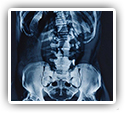Spondylolistheses, Low Back Pain, and Urinary Function Helped by Chiropractic
Print Article

The Journal of Clinical Medicine published the results of a study on March 30, 2024, that showed chiropractic helping three patients who had health issues resulting from spondylolistheses. According to the National Library of Medicine, National Center for Biotechnology Information, "Spondylolisthesis is a condition that occurs when one vertebral body slips with respect to the adjacent vertebral body causing radicular or mechanical symptoms or pain. It is graded based on the degree of slippage of one vertebral body on the adjacent vertebral body."
This study begins by explaining the impact that spinal pain can have on the overall quality of life and the residual effects the pain can have on organ functions. The authors also report that "Degenerative spondylolisthesis is prevalent in 6–31% of the United States population, with an elevated prevalence from 50 to 90 years of age and where the female to male ratio is 5 to 1."
This study reports on a case series involving three patients who went to a spinal rehabilitation facility for low back pain. All three patients had the following findings on their initial chiropractic visits: All three had significant lower back pain, and suffered from urgency of urination issues. Additionally, all had x-rays that showed an increase in their lower back curvature along with the visible presence of spondylolistheses. Included in this study was a man, age 68, and two women, ages 71 and 69.
All three patients were initially asked to fill out a 36-question health-related quality of life (HRQOL) questionnaire that could be compared to the same form later in their chiropractic care. This HRQOL is then scored from 0 to 100 with 100 being the highest rating of a good quality of life. This rating is divided into a physical component score (PCS) with a normal rating of 46.8, and a mental component score (MCS) with the normal being 52.8 out of 100.
Specific forms of chiropractic care were performed on the patients for between a 12 and 41 week dependent upon their specific spinal findings. The initial scores for the PCS and MCS were compared to those after the chiropractic care program as well as over a year after the care was rendered.
The man had initial scores of 21.8 for his PCS and 42.2 for his MCS score. After care the man's scores increased to 44.1 for his PCS and 62.7 for his MCS. The 71-year-old woman's initial PCS score was 32.6, which increased to 51.7 after care. Her MCS score went initially from 53.8 to 57.5 after care. The other woman, who was 69 years old, had an initial PCS score of 35.0 which raised to 54.8 after chiropractic care, while her MCS score went from 43.5 to 52.7. Over one year after chiropractic care had started, all three patients maintained higher scores in both categories.
In addition to the self-reported benefits in pain and quality of life as shown in their scores, all three patients also had improvements in their spondylolistheses as shown on their x-rays. Additionally, all three reported improvements in their urinary function issues.
The authors of the study commented on the success of chiropractic care in these cases by stating, "This case documents the first recorded long-term successful treatment of three senior patients (two females and one male) aged 68 to 71 years showing improvements in back pain, QOL, and urinary dysfunction following the correction of lumbar lordosis and reduction in lumbar spondylolistheses…" They also added, "This study adds to the growing body of research for healthcare providers and educators who can benefit from a better understanding of the impact of spinal health on human physiology and potential treatment options."
Print Article


